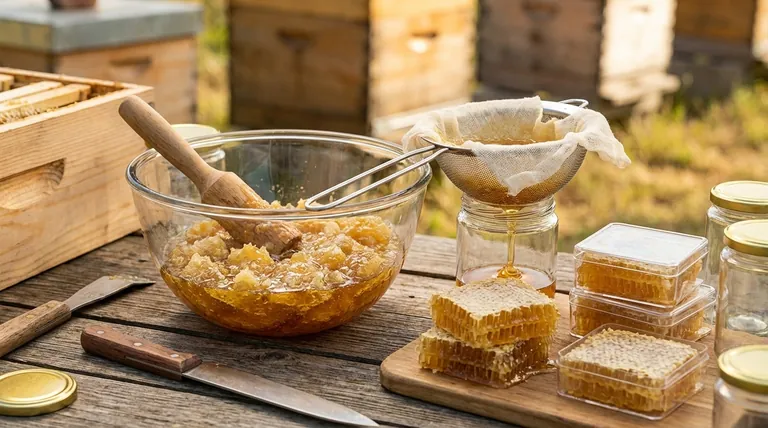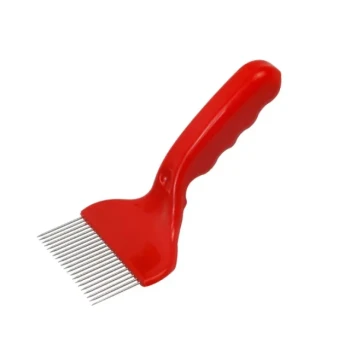To remove honey without an extractor, the most common and effective technique is the crush-and-strain method. This involves cutting the honeycomb from its frame, crushing it to break open the wax cells, and allowing the raw honey to drain through a filter—such as a colander lined with cheesecloth—into a clean, food-safe container.
While a mechanical extractor is prized for preserving the delicate beeswax comb, non-extractor methods offer a simple, low-cost alternative for hobbyists. The fundamental trade-off is sacrificing the comb, which requires your bees to expend significant energy to rebuild.

The Logic Behind Non-Extractor Methods
For many new or small-scale beekeepers, a mechanical extractor is an expensive and bulky piece of equipment that isn't justified for just one or two hives. These manual methods provide a perfectly viable way to harvest your honey.
The Crush-and-Strain Method
This is the workhorse technique for extracting liquid honey without a machine. It's straightforward but requires patience.
First, cut the honeycomb out of the frame and place it into a large, food-grade bucket or bowl. Using a clean potato masher or a similar tool, gently crush the comb just enough to break open the wax cells and release the honey.
Next, set up a straining system. Place a colander over a clean bucket and line it with a fine-mesh filter, like cheesecloth or a dedicated honey filter bag. Pour the crushed comb and honey mixture into the filter.
Finally, allow gravity to do the work. The honey will slowly drip through the filter, leaving the beeswax behind. This process can take several hours, or even overnight, for a complete drain.
The Cut-Comb Method
This approach isn't about extracting liquid honey but rather about harvesting sections of the comb to be consumed directly. It is often considered a delicacy.
This method is only suitable for frames that use a very thin, special foundation wax or no foundation at all.
You simply use a sharp, clean knife to cut out neat squares or rectangles of the capped honeycomb. These pieces of "comb honey" are then packaged and stored as-is, with the honey held inside its natural beeswax container.
Understanding the Trade-offs
Choosing not to use an extractor is a valid decision, but it's critical to understand the consequences, particularly for the health and productivity of your hive.
Sacrificing the Honeycomb
The single greatest benefit of a centrifugal extractor is that it removes honey while leaving the beeswax comb almost entirely intact. This is a massive advantage.
Bees expend enormous energy to produce wax and construct a single frame of comb. Returning an empty, intact comb to the hive allows the bees to immediately begin refilling it with honey, dramatically increasing their potential productivity for the season.
When you use the crush-and-strain method, you destroy this valuable resource. The bees must start from scratch, consuming significant amounts of nectar just to rebuild the wax structure before they can store any surplus honey.
Time and Labor Intensity
Mechanical extractors are designed for efficiency. They can process multiple frames at once, extracting honey in a matter of minutes.
The crush-and-strain method is inherently slow. The process of cutting, crushing, and especially draining is manual and can take many hours to complete. For a small harvest, this is manageable; for a large one, it becomes a significant bottleneck.
Making the Right Choice for Your Harvest
Your goal for the harvest should dictate your method. By understanding the core purpose of each technique, you can align your efforts with your desired outcome.
- If your primary focus is a simple, low-cost way to get liquid honey from a small number of frames: The crush-and-strain method is your most practical and effective option.
- If your primary focus is maximizing your hive's honey production season after season: Investing in or borrowing a honey extractor to preserve the comb is the superior long-term strategy.
- If your primary focus is producing a premium product to be eaten comb-and-all: The cut-comb method is specifically designed for this purpose.
Ultimately, choosing how to process your honey is a key part of the beekeeping journey that directly connects you to the final product.
Summary Table:
| Method | Primary Goal | Key Consideration |
|---|---|---|
| Crush-and-Strain | Harvest liquid honey simply & cheaply | Destroys wax comb; bees must rebuild |
| Cut-Comb | Produce comb honey as a premium product | Requires specific foundation; no liquid honey |
Ready to streamline your honey harvest? As a leading wholesale supplier to commercial apiaries and distributors, HONESTBEE provides the durable equipment—from filters to full extraction systems—that scales with your operation. Let's discuss how our solutions can boost your efficiency and protect your colony's productivity. Contact our expert team today for a consultation.
Visual Guide

Related Products
- 2 Frame Stainless Steel Manual Honey Spinner Extractor for Beekeeping
- 6 Frame Manual Stainless Steel Honey Extractor Beekeeping Equipment
- HONESTBEE 72 Frame Industrial Electric Honey Extractor for Beekeeping
- electric honey extractor honey centrifuge 3 frame honey extractor stainless steel honey frame extractor
- Plastic Hand Crank 2 Frame Honey Extractor Low Price
People Also Ask
- How often should a honey extractor be cleaned if used multiple times a year? Optimize Your Harvest Workflow
- How do beekeepers harvest honey from the honey super? A Step-by-Step Guide to Efficient Extraction
- What are some expert tips for cleaning a honey extractor? Protect Your Harvest & Equipment
- How can a pressure washer be used to clean a honey extractor? A Guide to Safe and Efficient Cleaning
- What mistakes should be avoided during honey extraction with a centrifuge? Preserve Your Comb and Honey Quality



















